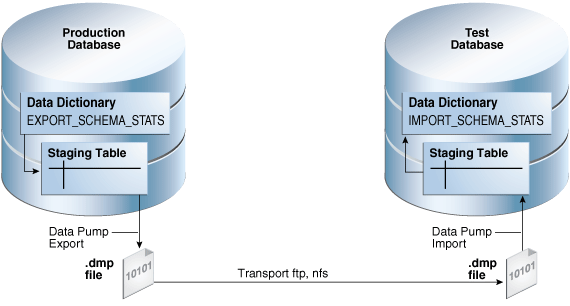17 Transporting Optimizer Statistics
You can export and import optimizer statistics from the data dictionary to user-defined statistics tables. You can also copy statistics from one database to another database.
This chapter contains the following topics:
- About Transporting Optimizer Statistics
When you transport optimizer statistics between databases, you must useDBMS_STATSto copy the statistics to and from a staging table, and tools to make the table contents accessible to the destination database. - Transporting Optimizer Statistics to a Test Database: Tutorial
You can transport schema statistics from a production database to a test database using Oracle Data Pump.
17.1 About Transporting Optimizer Statistics
When you transport optimizer statistics between databases, you must use DBMS_STATS to copy the statistics to and from a staging table, and tools to make the table contents accessible to the destination database.
Importing and exporting are especially useful for testing an application using production statistics. You use DBMS_STATS.EXPORT_SCHEMA_STATS to export schema statistics from a production database to a test database so that developers can tune execution plans in a realistic environment before deploying applications.
The following figure illustrates the process using Oracle Data Pump and ftp.
Figure 17-1 Transporting Optimizer Statistics

Description of "Figure 17-1 Transporting Optimizer Statistics"
As shown in Figure 17-1, the basic steps are as follows:
-
In the production database, copy the statistics from the data dictionary to a staging table using
DBMS_STATS.EXPORT_SCHEMA_STATS. -
Export the statistics from the staging table to a
.dmpfile using Oracle Data Pump. -
Transfer the
.dmpfile from the production host to the test host using a transfer tool such asftp. -
In the test database, import the statistics from the
.dmpfile to a staging table using Oracle Data Pump. -
Copy the statistics from the staging table to the data dictionary using
DBMS_STATS.IMPORT_SCHEMA_STATS.
17.2 Transporting Optimizer Statistics to a Test Database: Tutorial
You can transport schema statistics from a production database to a test database using Oracle Data Pump.
Prerequisites and Restrictions
When preparing to export optimizer statistics, note the following:
-
Before exporting statistics, you must create a table to hold the statistics. The procedure
DBMS_STATS.CREATE_STAT_TABLEcreates the statistics table. -
The optimizer does not use statistics stored in a user-owned table. The only statistics used by the optimizer are the statistics stored in the data dictionary. To make the optimizer use statistics in user-defined tables, import these statistics into the data dictionary using the
DBMS_STATSimport procedure. -
The Data Pump Export and Import utilities export and import optimizer statistics from the database along with the table. When a column has system-generated names, Original Export (
exp) does not export statistics with the data, but this restriction does not apply to Data Pump Export.Note:
Exporting and importing statistics using
DBMS_STATSis a distinct operation from using Data Pump Export and Import.
Assumptions
This tutorial assumes the following:
-
You want to generate representative
shschema statistics on a production database and useDBMS_STATSto import them into a test database. -
Administrative user
dba1exists on both production and test databases. -
You intend to create table
opt_statsto store the schema statistics. -
You intend to use Oracle Data Pump to export and import table
opt_stats.
To generate schema statistics and import them into a separate database:
-
On the production host, start SQL*Plus and connect to the production database as administrator
dba1. -
Create a table to hold the production statistics.
For example, execute the following PL/SQL program to create user statistics table
opt_stats:BEGIN DBMS_STATS.CREATE_STAT_TABLE ( ownname => 'dba1' , stattab => 'opt_stats' ); END; / -
Gather schema statistics.
For example, manually gather schema statistics as follows:
-- generate representative workload EXEC DBMS_STATS.GATHER_SCHEMA_STATS('SH'); -
Use
DBMS_STATSto export the statistics.For example, retrieve schema statistics and store them in the
opt_statstable created previously:BEGIN DBMS_STATS.EXPORT_SCHEMA_STATS ( ownname => 'dba1' , stattab => 'opt_stats' ); END; / -
Use Oracle Data Pump to export the contents of the statistics table.
For example, run the
expdpcommand at the operating schema prompt:expdp dba1 DIRECTORY=dpump_dir1 DUMPFILE=stat.dmp TABLES=opt_stats -
Transfer the dump file to the test database host.
-
Log in to the test host, and then use Oracle Data Pump to import the contents of the statistics table.
For example, run the
impdpcommand at the operating schema prompt:impdp dba1 DIRECTORY=dpump_dir1 DUMPFILE=stat.dmp TABLES=opt_stats -
On the test host, start SQL*Plus and connect to the test database as administrator
dba1. -
Use
DBMS_STATSto import statistics from the user statistics table and store them in the data dictionary.The following PL/SQL program imports schema statistics from table
opt_statsinto the data dictionary:BEGIN DBMS_STATS.IMPORT_SCHEMA_STATS( ownname => 'dba1' , stattab => 'opt_stats' ); END; /
See Also:
-
Oracle Database PL/SQL Packages and Types Reference to learn about the
DBMS_STATS.CREATE_STAT_TABLEfunction -
Oracle Database PL/SQL Packages and Types Reference for an overview of the statistics transfer functions
-
Oracle Database Utilities to learn about Oracle Data Pump